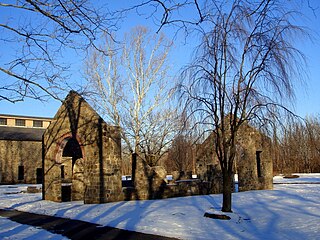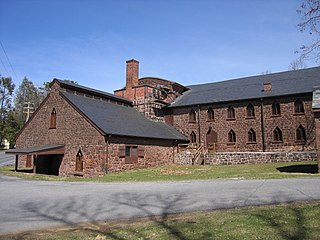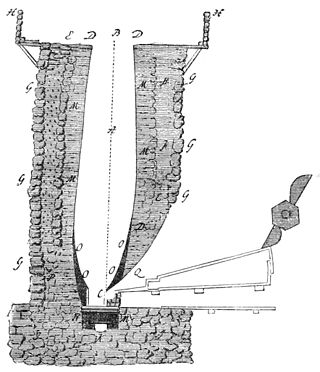Related Research Articles

Coke is a grey, hard, and porous coal-based fuel with a high carbon content and few impurities, made by heating coal or oil in the absence of air—a destructive distillation process. It is an important industrial product, used mainly in iron ore smelting, but also as a fuel in stoves and forges when air pollution is a concern.

Anthracite, also known as hard coal and black coal, is a hard, compact variety of coal that has a submetallic lustre. It has the highest carbon content, the fewest impurities, and the highest energy density of all types of coal and is the highest ranking of coals.

Steelmaking is the process of producing steel from iron ore and/or scrap. In steelmaking, impurities such as nitrogen, silicon, phosphorus, sulfur and excess carbon are removed from the sourced iron, and alloying elements such as manganese, nickel, chromium, carbon and vanadium are added to produce different grades of steel.

A blast furnace is a type of metallurgical furnace used for smelting to produce industrial metals, generally pig iron, but also others such as lead or copper. Blast refers to the combustion air being supplied above atmospheric pressure.

The Wealden iron industry was located in the Weald of south-eastern England. It was formerly an important industry, producing a large proportion of the bar iron made in England in the 16th century and most British cannon until about 1770. Ironmaking in the Weald used ironstone from various clay beds, and was fuelled by charcoal made from trees in the heavily wooded landscape. The industry in the Weald declined when ironmaking began to be fuelled by coke made from coal, which does not occur accessibly in the area.
Anthracite iron or anthracite pig iron is iron extracted by the smelting together of anthracite coal and iron ore, that is using anthracite coal instead of charcoal in iron smelting. This was an important technical advance in the late-1830s, enabling a great acceleration of the Industrial Revolution in the United States and in Europe.

A reverberatory furnace is a metallurgical or process furnace that isolates the material being processed from contact with the fuel, but not from contact with combustion gases. The term reverberation is used here in a generic sense of rebounding or reflecting, not in the acoustic sense of echoing.

An ironworks or iron works is an industrial plant where iron is smelted and where heavy iron and steel products are made. The term is both singular and plural, i.e. the singular of ironworks is ironworks.

Abraham Darby, in his later life called Abraham Darby the Elder, now sometimes known for convenience as Abraham Darby I, was a British ironmaster and foundryman. Born into an English Quaker family that played an important role in the Industrial Revolution, Darby developed a method of producing pig iron in a blast furnace fuelled by coke rather than charcoal. This was a major step forward in the production of iron as a raw material for the Industrial Revolution.

Hot blast refers to the preheating of air blown into a blast furnace or other metallurgical process. As this considerably reduced the fuel consumed, hot blast was one of the most important technologies developed during the Industrial Revolution. Hot blast also allowed higher furnace temperatures, which increased the capacity of furnaces.

The Lehigh Crane Iron Company, later renamed Crane Iron Company, was a major ironmaking firm in the Lehigh Valley from its founding in 1839 until its sale in 1899. It was based in Catasauqua, Pennsylvania, and was founded by Josiah White and Erskine Hazard, who financed its development through their Lehigh Coal & Navigation Company, which promoted the then-novel technique of smelting iron ore with anthracite coal. This was an important cost and energy savings technique, credited with eliminating the need for either expensive charcoal or coke producing processes and transport costs that proved central to the acceleration of the American industrial revolution.

The Thomas Iron Company was a major iron-making firm in Hokendauqua, Pennsylvania in the Lehigh Valley region of eastern Pennsylvania from its founding in 1854 until its decline and eventual dismantling in the early 20th century.

Lock Ridge Park is a park built around a historic iron ore blast furnace just outside Alburtis, Pennsylvania in the Lehigh Valley region of eastern Pennsylvania.

Cornwall Iron Furnace is a designated National Historic Landmark that is administered by the Pennsylvania Historical and Museum Commission in Cornwall, Lebanon County, Pennsylvania in the United States. The furnace was a leading Pennsylvania iron producer from 1742 until it was shut down in 1883. The furnaces, support buildings and surrounding community have been preserved as a historical site and museum, providing a glimpse into Lebanon County's industrial past. The site is the only intact charcoal-burning iron blast furnace in its original plantation in the western hemisphere. Established by Peter Grubb in 1742, Cornwall Furnace was operated during the Revolution by his sons Curtis and Peter Jr. who were major arms providers to George Washington. Robert Coleman acquired Cornwall Furnace after the Revolution and became Pennsylvania's first millionaire. Ownership of the furnace and its surroundings was transferred to the Commonwealth of Pennsylvania in 1932.
Wundowie is a town in Western Australia located between Perth and Northam in the Darling Range. It was the location of an iron works, and siding and stopping place on the Eastern Railway.

The tatara (鑪) is a traditional Japanese furnace used for smelting iron and steel. The word later also came to mean the entire building housing the furnace. The traditional steel in Japan comes from ironsand processed in a special way, called the tatara system.

Cold blast, in ironmaking, refers to a metallurgical furnace where air is not preheated before being blown into the furnace. This represents the earliest stage in the development of ironmaking. Until the 1820s, the use of cold air was thought to be preferable to hot air for the production of high-quality iron; this effect was due to the reduced moisture in cool winter air.

The US iron and steel industry has paralleled the industry in other countries in technological developments. In the 1800s, the US switched from charcoal to coal in ore smelting, adopted the Bessemer process, and saw the rise of very large integrated steel mills. In the 20th century, the US industry successively adopted the open hearth furnace, then the basic oxygen steelmaking process. Since the American industry peaked in the 1940s and 1950s, the US industry has shifted to small mini-mills and specialty mills, using iron and steel scrap as feedstock, rather than iron ore.

Metallurgical coal or coking coal is a grade of coal that can be used to produce good-quality coke. Coke is an essential fuel and reactant in the blast furnace process for primary steelmaking. The demand for metallurgical coal is highly coupled to the demand for steel. Primary steelmaking companies often have a division that produces coal for coking, to ensure a stable and low-cost supply.

The Wundowie charcoal iron and wood distillation plant manufactured pig iron between 1948 and 1981 and wood distillation products between 1950 and 1977, at Wundowie, Western Australia.
References
- ↑ Bartholomew & Metz 1988, p. 31.
- ↑ Williams 2003, p. 316.
- ↑ Ridden, Philip A Gazetteer of Charcoal-fired Blast Furnaces in Great Britain in use since 1660 Merton Priory press, 1987, 2nd edn 1993 ISBN 0-9520009-1-1
- 1 2 Relix & Fiona Bush Heritage and Archaeology. "Wundowie Garden Town Conservation Plan" (PDF). Wundowie Progress Association. Archived (PDF) from the original on 2019-10-24.
- ↑ Meyers, Henri; Jennings, R. P. (2 November 1979). "Charcoal Ironmaking, A Technical and Economic Review of Brazilian Experience". United Nations Industrial Development Organization.
- ↑ Couto, Laércio; Nicholas, Ian; Wright, Lynn (2011). "Short Rotation Eucalypt Plantations for Energy in Brazil" (PDF). Archived (PDF) from the original on 2022-01-20.
- ↑ Faleiro, R.M.R.; Velloso, C.M.; de Castro, L.F.A.; Sampaio, R.S. (2013). "Statistical Modelling of Charcoal Consumption of V & M do Brasil's Blast Furnaces in Relation to Hot Metal Production and Ferrous Loads" (PDF).